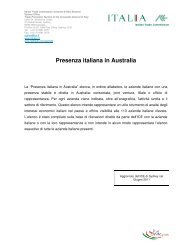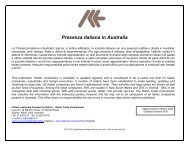Price Determination in the Australian Food Industry A Report
Price Determination in the Australian Food Industry A Report
Price Determination in the Australian Food Industry A Report
Create successful ePaper yourself
Turn your PDF publications into a flip-book with our unique Google optimized e-Paper software.
APPLES – ANALYSIS OF PRICING<br />
The <strong>in</strong>dustry’s product and market mix<br />
There has been an <strong>in</strong>significant change <strong>in</strong> <strong>the</strong> total volume of <strong>Australian</strong> apple production over <strong>the</strong><br />
past decade. There has been a modest <strong>in</strong>crease <strong>in</strong> per capita apple consumption <strong>in</strong> recent years<br />
(for example, 1995 = 12.3kgs, 1999 = 15.3kgs). Both fresh sales and juice sales have shared <strong>the</strong><br />
<strong>in</strong>crease.<br />
Figure 60. Total <strong>in</strong>dustry production, apples, ’000 tonnes, 1997–2000<br />
’000<br />
tonnes<br />
400<br />
350<br />
300<br />
250<br />
fresh exports<br />
fresh domestic<br />
Aust processed<br />
200<br />
150<br />
100<br />
50<br />
0<br />
1997 1998 1999 2000<br />
Source: ABS 2002<br />
Exports rema<strong>in</strong> small <strong>in</strong> importance to <strong>the</strong> total <strong>in</strong>dustry with m<strong>in</strong>imal <strong>in</strong>fluence on overall returns.<br />
By far <strong>the</strong> bulk of <strong>Australian</strong> retail apple sales are <strong>in</strong> a loose, undifferentiated form. Small amounts<br />
are bagged (generally small sizes of ma<strong>in</strong> volume l<strong>in</strong>es). Some fruit (for example, p<strong>in</strong>k lady) is sold<br />
from s<strong>in</strong>gle layer trays. The emergence of new apple varieties (such as gala) has added some<br />
upward pressure to values but <strong>in</strong> general <strong>the</strong> slow <strong>in</strong>dustry change away from old, less preferred<br />
varieties (for example, red delicious) has <strong>in</strong>creased downward pressure on prices.<br />
Factors affect<strong>in</strong>g prices through <strong>the</strong> cha<strong>in</strong><br />
• Seasonal production variation is <strong>the</strong> biggest driver of prices and returns.<br />
• At retail, apples compete with o<strong>the</strong>r fresh fruit l<strong>in</strong>es such as stone fruit and bananas. Seasonal<br />
availability can provide advantages but <strong>the</strong>re is <strong>in</strong>creas<strong>in</strong>g availability of range across <strong>the</strong> board<br />
which removes such advantages.<br />
• O<strong>the</strong>r key <strong>in</strong>-season fruit items (ma<strong>in</strong>ly oranges, mandar<strong>in</strong>s and bananas) affect <strong>the</strong> choice of<br />
apple purchases based on <strong>the</strong>ir relative value and quality dur<strong>in</strong>g <strong>the</strong> apple season. Over time,<br />
o<strong>the</strong>r snack food options have also greatly affected <strong>the</strong> demand and potential returns for<br />
apples.<br />
• The apple <strong>in</strong>dustry still suffers from a reputation for hav<strong>in</strong>g highly variable quality and<br />
availability between and dur<strong>in</strong>g seasons. Variations <strong>in</strong> region, time of season, retailer and<br />
variety also cause much fluctuation <strong>in</strong> apple retail pric<strong>in</strong>g and adds to consumer uncerta<strong>in</strong>ty and<br />
confusion.<br />
• Varietal prices vary greatly depend<strong>in</strong>g on consumer preference and supply.<br />
• There are currently no apple imports <strong>in</strong>to Australia to affect market supply and demand. The<br />
ma<strong>in</strong> issue is <strong>the</strong> restriction on <strong>the</strong> import of New Zealand apples due to quarant<strong>in</strong>e concerns<br />
about fire blight.<br />
• The New Zealand fire blight issue has recently become affected by a successful United States<br />
challenge <strong>in</strong> <strong>the</strong> World Trade Organisation. This may <strong>in</strong>crease pressure <strong>in</strong> <strong>the</strong> medium term to<br />
allow access of New Zealand apples <strong>in</strong>to Australia. This would have a significant impact on <strong>the</strong><br />
<strong>Australian</strong> market and <strong>in</strong>dustry restructur<strong>in</strong>g.<br />
• Currency has a highly significant impact on trade each year. Significant flows of apples move <strong>in</strong><br />
and out of export each year due directly to currency-affected export competitiveness. For<br />
example, a 10 per cent export volume change causes a 3,000 tonne movement of apples <strong>in</strong> or<br />
out of <strong>the</strong> local market.<br />
<strong>Price</strong> <strong>Determ<strong>in</strong>ation</strong> <strong>in</strong> <strong>the</strong> <strong>Australian</strong> <strong>Food</strong> <strong>Industry</strong> A <strong>Report</strong><br />
63







